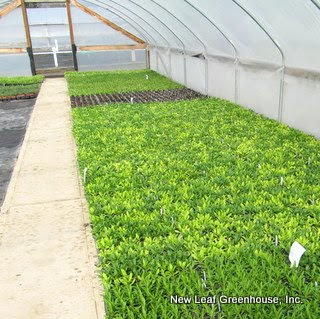
The summer's cool temperatures and showery weather have been kind to the plants that remain in nurseries. Without hot days and dry winds, plant quality remains very high. Our own retail store is still full of lovely blooming plants, and we are shipping top quality annual and perennial plants to our customers around the northwest.
Every summer, I end up looking at a lot of unsold regal geraniums. We used to call these Martha Washington geraniums, but the "regal" name is shorter for data entry, and also less fussy. Customers just don't seem to understand how durable and floriferous these plants are.... we sell most of them as presentation plants around Easter and Mothers' Day - which is a pity since they are one of the showiest and toughest of all the grandiflora bloomers for our area. I also think that many customers think they are shade plants - maybe because the flowers are so stupendous. In the shade, and if overwatered, regals just don't keep blooming like they do in full sun. I have to admit that I used to think that they were fragile pot plants, but our experience with summer performance has shown them to be amazing performers.
Here are some regal hanging baskets shipping today to customers in Seattle; they are 24" in diameter and completely covered with flowers and new bud clusters.
If you have a shady garden, Alstromerias are wonderful summer bloomers, and terrific cut flowers as well. The varieties that we grow don't have the long stems of florist alstromerias but are still nice for small arrangements.... the produce SOOO many flowers that a few stems son't be missed. Alstromeria is winter hardy in the Northwest, and has a long period of summer bloom. There are many colors available, but I am especially fond of this deep cerise red shade.
Another nice new plant for us is Campanula Uniform Blue. I personally love the whole Campanula family, and have grown hundreds of varieties of them in my 34 years as a perennial grower. This variety is substantial and compact, and has smothered itself with buds. I have read that there are more than 400 campanulas in cultivation... I thought that they were all from Europe and Asia, but I see in my Bailey's "Manual of Cultivated Plants" that some species originate in North America.
Stores were flooded with coleus this spring- who knows what happened to all those plants sold in April and early May when it was so very cold and wet. They really don't grow well until the nights warm up... and they are doing beautifully now. We also have a lot of Kong varieties grown from seed. You can confidently plant all these new varieties in full sun... that's what they love.
There are also rudbeckias and zinnias tucked in under the coleus for this shipment. They are heat-lovers that will perform beautifully from now until frost.
Here's a shot of Julio working on a shipment of Geranium-dracaena planters for a customer. They are way too big to ship economically, but customers love them and we don't want to dump them when everything winds down in a few weeks.
In the nursery, rooted poinsettia cuttings continue to arrive. Varieties that will be planted in 6" pots are planted directly; those for double-stick 8" plants will be shifted to their final container in a few weeks. Fall mums are all in their final pots, and next years' perennials from cuttings have been rooted and are growing on in 2" cells. We are doing a big field inventory right now to see what else we need to get underway from seed, and we are planning our 4" perennial crop right now. Busy!



































